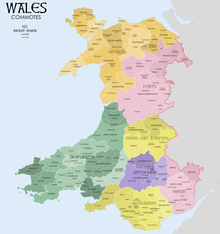
A commote (Welsh: cwmwd, sometimes spelt in older documents as cymwd, plural cymydau, less frequently cymydoedd)[1] was a secular division of land in Medieval Wales. The word derives from the prefix cym- ("together", "with") and the noun bod ("home, abode").[1] The English word "commote" is derived from the Middle Welsh cymwt.[2]
The basic unit of land was the tref, a small basic village or settlement. In theory, 100 trefi made up a cantref (literally, "one hundred settlements"; plural: cantrefi), and half or a third of a cantref was a cymwd, although in practice the actual numbers varied greatly. Together with the cantrefi, commotes were the geographical divisions through which defence and justice were organised. In charge of a commote would be a chieftain probably related to the ruling Prince of the Kingdom. His court would have been situated in a special tref, referred to as a maerdref. Here, the bonded villagers who farmed the chieftain's estate lived, together with the court officials and servants.[3] Commotes were further divided into maenorau or maenolydd.
- ^ a b Geiriadur Prifysgol Cymru (University of Wales Dictionary), p. 643
- ^ Brown, Lesley (ed), "New Shorter Oxford English Dictionary", Clarendon Press, Oxford, 1993 ISBN 0-19-861134-X
- ^ Rhys & Brynmor-Jones 1906:401–402, The Welsh People
